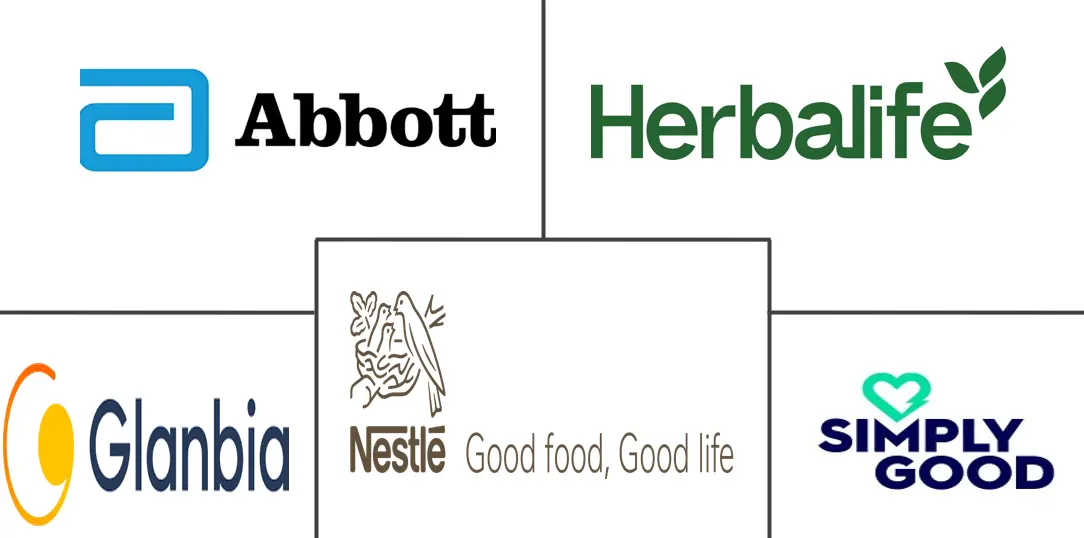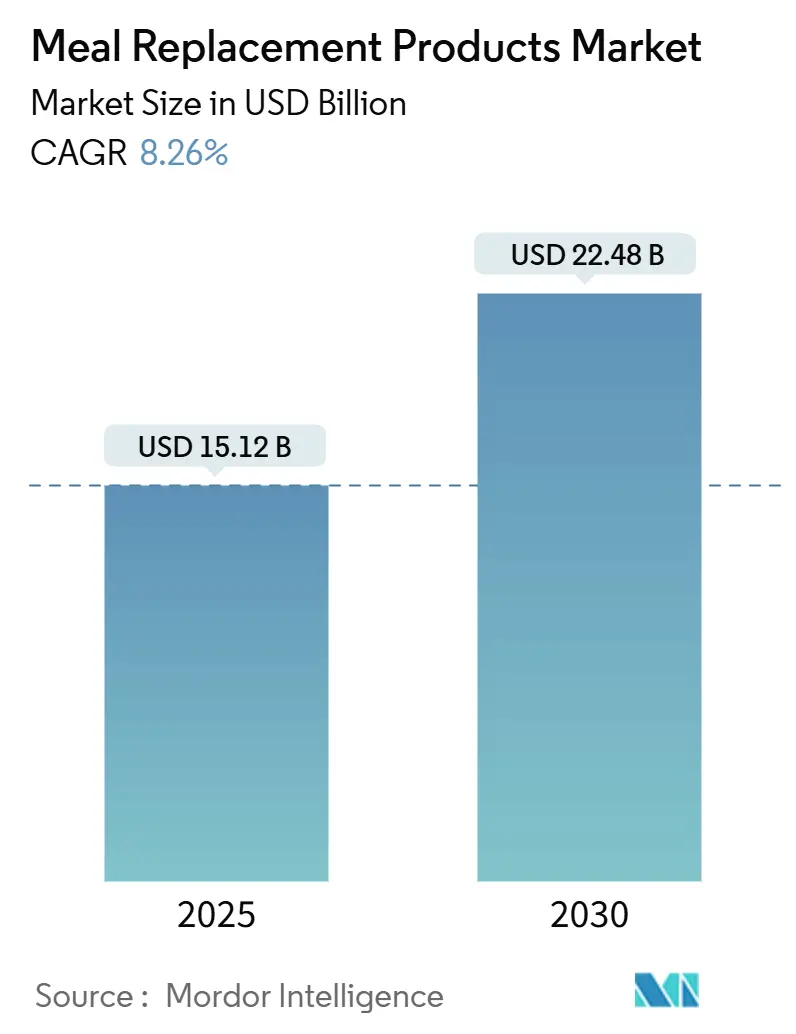
Meal Replacement Products Market Analysis by Mordor Intelligence
The global meal replacement market is valued at USD 15.12 billion in 2025 and is projected to reach USD 22.48 billion by 2030, registering a compound annual growth rate (CAGR) of 8.26% during the forecast period. This expansion reflects the convergence of health-conscious consumer behavior, technological innovations in food processing. The meal replacement market is experiencing significant transformation driven by changing consumer preferences and lifestyle patterns. The increasing focus on preventive health management and wellness has become a dominant force shaping the market landscape. This health consciousness has led manufacturers to develop more sophisticated and nutritionally balanced meal replacement products. The industry has witnessed a notable shift toward clean-label replacement products, with consumers demanding transparency in ingredient sourcing and processing methods.
Key Report Takeaways
- By product type, powders led with 41.04% of the meal replacement market share in 2024; RTD shakes are on track for an 11.01% CAGR during 2025-2030.
- By packaging format, bottles and jars captured 72.11% of the meal replacement market in 2024, while Tetra Packs are set to expand at a 9.25% CAGR through 2030.
- By nature, conventional formulas held a 92.04% share in 2024; the organic segment is projected to post the fastest 10.11% CAGR.
- By distribution channel, supermarkets and hypermarkets accounted for 54.65% revenue share in 2024; online retail leads growth at 11.04% CAGR.
- By geography, North America commanded 41.92% of the meal replacement market size in 2024, whereas Asia-Pacific is forecast to progress at a 10.22% CAGR.
Global Meal Replacement Products Market Trends and Insights
Drivers Impact Analysis
| Drivers | (~) % Impact on CAGR Forecasts | Geographic Relevance | Impact Timeline |
|---|---|---|---|
| Busy Lifestyles Fuel Demand for Convenient and Nutritious Meal Options | +1.8% | Global, with highest impact in North America and urban Asia-Pacific | Medium term (2-4 years) |
| Rising Health and Fitness Consciousness Boosts Demand for Protein-Enriched Meal Replacements | +2.1% | Global, particularly strong in developed markets | Long term (≥ 4 years) |
| Proliferation of E-Commerce Platforms Expands Global Accessibility and Brand Reach | +1.5% | Global, with accelerated adoption in Asia-Pacific and Latin America | Short term (≤ 2 years) |
| Workplace Wellness Programs Encourage the Use of Meal Replacements as Healthy On-the-Go Solutions | +0.9% | North America and Europe, expanding to Asia-Pacific | Medium term (2-4 years) |
| Greater Awareness of Portion Control and Calorie Management Encourages Meal Replacement Adoption | +1.2% | Global, with emphasis on obesity-prevalent regions | Long term (≥ 4 years) |
| Advances in Food Technology Improve Taste, Texture, Shelf Life, and Nutrient Profiles | +0.8% | Global, led by innovation hubs in North America and Europe | Long term (≥ 4 years) |
| Source: Mordor Intelligence | |||
Busy Lifestyles Fuel Demand for Convenient and Nutritious Meal Options
The acceleration of urbanization and evolving work patterns is fundamentally reshaping meal consumption behaviors, with meal delivery services experiencing growth as companies replace traditional cafeterias with flexible meal solutions. This shift extends beyond corporate environments, as evidenced by Factor's corporate meal delivery program gaining traction among employers seeking to enhance employee satisfaction and office attendance rates. The convergence of remote work flexibility and in-office requirements is creating demand for portable nutrition solutions that maintain consistency across different work environments. Quest Nutrition's launch of protein milkshakes in February 2025, containing 45 grams of protein in 14-ounce bottles, exemplifies how manufacturers are responding to consumer needs for nutrient-dense, grab-and-go options. The trend is particularly pronounced among millennials and Gen Z consumers who prioritize convenience without compromising nutritional quality, driving innovation in packaging formats and product formulations that support active lifestyles.
Rising Health and Fitness Consciousness Boosts Demand for Protein-Enriched Meal Replacements
This health consciousness extends beyond traditional fitness enthusiasts to include aging populations seeking muscle preservation, as demonstrated by Abbott's strategic partnership with the Professional Pickleball Association to promote muscle health through high-protein products like Ensure Max Protein. The integration of functional ingredients is becoming increasingly sophisticated, with companies like Koia launching Elite shakes containing 32 grams of complete plant protein while avoiding seed oils and artificial sweeteners, in January 2025. Scientific validation is driving product development, with peer-reviewed research demonstrating that protein-enriched intermittent meal replacement combined with moderate-intensity training produces superior weight loss outcomes compared to exercise alone. The trend is further amplified by social media influencers and celebrities promoting strength over traditional beauty standards, creating cultural momentum that supports sustained market growth.
Proliferation of E-Commerce Platforms Expands Global Accessibility and Brand Reach
E-commerce platforms such as Shopee and Lazada have become essential sales channels, particularly in Malaysia and Vietnam, where online shopping adoption rates are highest. These platforms enable companies to access previously unreachable consumer segments by providing direct-to-consumer sales opportunities and expanding their digital presence. The digital transformation encompasses personalized nutrition platforms, where AI-powered meal planning applications improve gut microbiome diversity and reduce diet-related health risks through tailored dietary recommendations and real-time monitoring. Companies use data analytics to refine product recommendations and increase customer retention by analyzing purchase patterns, consumer preferences, and behavioral data. Subscription models are gaining popularity as they ensure regular product delivery, strengthen long-term consumer relationships, and provide predictable revenue streams while offering consumers convenience and personalized experiences.
Workplace Wellness Programs Encourage the Use of Meal Replacements as Healthy On-the-Go Solutions
Corporate wellness initiatives are evolving beyond traditional health screenings to encompass comprehensive nutrition support, with companies recognizing that employee dietary choices directly impact productivity and healthcare costs. The shift from centralized cafeterias to distributed meal solutions reflects changing workforce dynamics, as organizations seek flexible options that accommodate hybrid work arrangements while maintaining nutritional standards. Abbott's collaboration with the National Association of Community Health Centers demonstrates how nutrition companies are partnering with healthcare organizations to integrate meal replacements into clinical care protocols, addressing food insecurity affecting 12.8% of U.S. households. The integration of meal replacements into workplace wellness programs is supported by emerging research on personalized nutrition, with AI-driven dietary interventions showing measurable improvements in metabolic health markers within six-week periods. Companies are increasingly viewing nutrition support as a strategic investment in human capital, recognizing that well-nourished employees demonstrate higher engagement levels and reduced absenteeism rates.
Restraint Impact Analysis
| Restraints | (~) % Impact on CAGR Forecasts | Geographic Relevance | Impact Timeline |
|---|---|---|---|
| Consumer Skepticism Toward Artificial Additives and Preservatives Limits Product Acceptance | -1.4% | Global, particularly pronounced in Europe and health-conscious segments | Medium term (2-4 years) |
| Inability to Fully Replicate the Satiety and Experience of Traditional Meals Limits Repeat Purchases | -1.1% | Global, with cultural variations in meal importance | Long term (≥ 4 years) |
| Product Recalls and Quality Concerns Undermine Consumer Trust and Brand Loyalty | -0.8% | Global, with heightened impact in regulated markets like North America and Europe | Short term (≤ 2 years) |
| Presence of Common Allergens Restricts Market to Allergen-Free Segments | -0.6% | Global, with higher impact in developed markets with allergen labeling requirements | Medium term (2-4 years) |
| Source: Mordor Intelligence | |||
Consumer Skepticism Toward Artificial Additives and Preservatives Limits Product Acceptance
The clean-label movement is intensifying consumer scrutiny of ingredient lists, with the FDA's initiative to eliminate synthetic dyes by 2026 reflecting broader regulatory pressure to reduce artificial additives in food products. This skepticism is driving innovation in natural alternatives, as demonstrated by Sparxell's development of biodegradable, plant-based colors using patented cellulose technology to replace synthetic dyes. The European Union's[1]European Food Safety Authority, “Updated Guidance on Novel Foods Applications,” efsa.europa.eu updated Novel Foods guidance, effective February 2025, is establishing stricter safety assessment protocols that require comprehensive documentation of production processes and safety data for new ingredients. Consumer education initiatives are becoming critical for market acceptance, as companies must balance functional ingredient benefits with transparency requirements. The challenge is particularly acute for protein fortification, where achieving desired nutritional profiles while maintaining clean labels requires sophisticated formulation expertise and often results in higher production costs that may limit market accessibility.
Inability to Fully Replicate the Satiety and Experience of Traditional Meals Limits Repeat Purchases
The fundamental challenge of meal replacement products lies in addressing both physiological and psychological aspects of eating, with traditional meals providing sensory experiences and social connections that processed alternatives struggle to replicate. Research on meal replacement effectiveness indicates that while products can successfully support weight management goals, long-term adherence remains challenging due to monotony and reduced meal satisfaction compared to whole food alternatives. The industry is responding through texture innovation and flavor diversification, with companies like Huel launching Daily Greens supplements to complement their core meal replacement offerings and address nutritional gaps. Cultural factors significantly influence acceptance rates, with Asian markets showing different adoption patterns compared to Western markets due to varying meal traditions and social eating customs. The emergence of hybrid products that combine meal replacement benefits with more traditional food formats, such as Arla Foods Ingredients' Essentials Bar, which avoids whey protein to maintain soft texture while meeting whole food standards, represents industry efforts to bridge the gap between convenience and meal satisfaction
Segment Analysis
By Product Type: Ready-to-Drink Surge Challenges Powder Dominance
Powdered products maintain market leadership with 41.04% share in 2024, benefiting from cost efficiency and customization flexibility that appeals to budget-conscious consumers and fitness enthusiasts seeking precise nutritional control. However, ready-to-drink products are experiencing the fastest growth at 11.01% CAGR from 2025-2030, driven by convenience demands and significant taste improvements that are attracting mainstream consumers beyond traditional supplement users.
The competitive dynamics within product types are being reshaped by technological innovations, particularly in protein processing and flavor masking technologies that enable clear protein beverages and improved taste profiles. Huel's launch of Complete Protein powder in March 2024, positioned as the world's first nutritionally complete vegan protein powder, demonstrates how companies are differentiating through comprehensive nutritional profiles rather than a single-nutrient focus. The integration of functional ingredients like probiotics, adaptogens, and specialized proteins is creating premium sub-segments within each product category, with companies leveraging scientific validation to justify higher price points and build consumer loyalty through perceived health benefits.
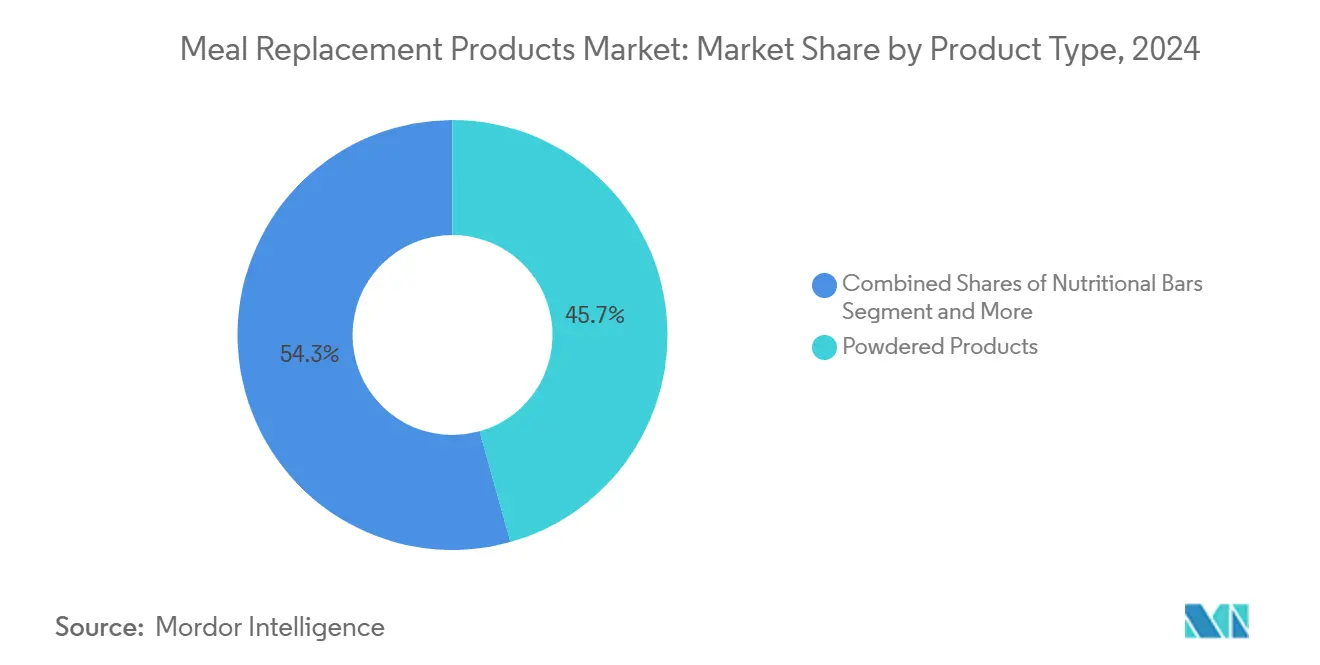
Note: Segment shares of all individual segments available upon report purchase
By Packaging Format: Sustainability Drives Innovation Beyond Convenience
Bottles and jars dominate with 72.11% market share in 2024, reflecting consumer preferences for resealable, portion-controlled packaging that maintains product freshness and enables gradual consumption. Tetra Packs and cartons are experiencing the fastest growth at 9.25% CAGR from 2025-2030, driven by sustainability initiatives and technological advances that improve barrier properties and extend shelf life without refrigeration requirements.
The packaging evolution extends beyond material selection to include smart packaging technologies that enhance user experience and product integrity. Tetra Pak's Factory Sustainable Solutions, launched in May 2024, demonstrates how packaging companies are integrating sustainability throughout the production process, including nanofiltration for cleaning, liquid reclamation, and renewable energy integration. The shift toward sustainable packaging is creating competitive advantages for companies that can balance environmental responsibility with functional requirements, as consumers increasingly factor packaging sustainability into purchase decisions alongside nutritional content and taste preferences.
By Nature: Organic Premium Commands Growth Despite Small Base
Conventional products maintain overwhelming dominance with 92.04% market share in 2024, reflecting price sensitivity and established supply chains that enable mass market accessibility across diverse consumer segments. The organic segment, despite representing only 7.96% of the market, is achieving the fastest growth at 10.11% CAGR from 2025-2030, driven by premium positioning and consumer willingness to pay higher prices for perceived health and environmental benefits. The organic segment's expansion is constrained by supply chain complexities and certification requirements that limit ingredient availability and increase production costs.
According to the Organic Trade Association[2]Organic Trade Association, "US Organic Food Sales", www.ota.com data from 2023, organic food sales in the United States were USD 63.8 billion. The organic segment's development is being accelerated by corporate sustainability commitments and consumer education about environmental impact differences between conventional and organic production methods. The premium pricing strategy for organic products is enabling companies to invest in research and development for innovative ingredients and processing technologies, creating a virtuous cycle that drives continued segment growth despite the higher cost structure.
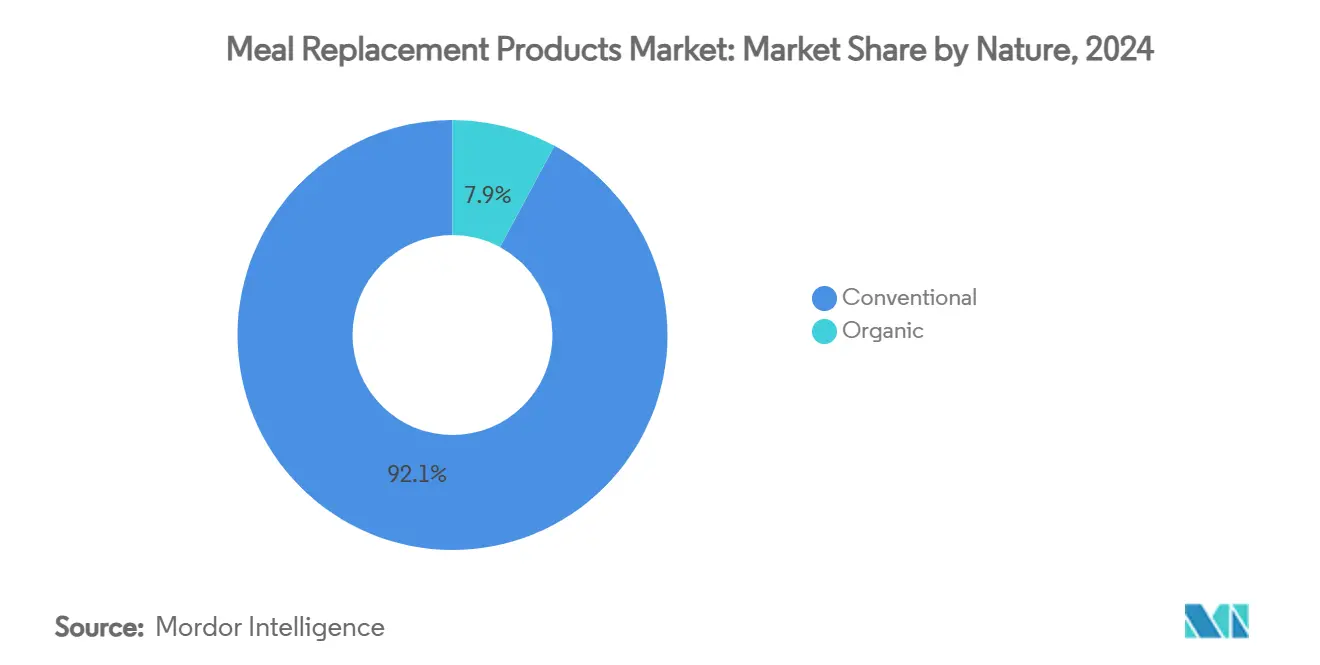
By Distribution Channel: Digital Transformation Accelerates Online Growth
Supermarkets and hypermarkets retain the largest share at 54.65% in 2024, benefiting from established consumer shopping patterns and the ability to provide immediate product availability alongside complementary grocery purchases. Online retailers are experiencing the fastest growth at 11.04% CAGR from 2025-2030, accelerated by improved logistics capabilities and consumer comfort with digital purchasing for health and nutrition products. The online channel's growth is exemplified by brands like Nurri launching protein milkshakes exclusively at Costco in September 2024 before expanding to broader retail networks, demonstrating how companies are using strategic partnerships to build market presence. Convenience stores and specialty stores serve specific consumer needs, with convenience stores capturing impulse purchases and specialty stores providing expert guidance for health-focused consumers.
The distribution landscape is being transformed by omnichannel strategies that integrate online and offline touchpoints to optimize consumer experience and operational efficiency. Companies are leveraging data analytics to understand consumer behavior across channels and optimize inventory allocation, with subscription models becoming increasingly important for building customer loyalty and ensuring consistent revenue streams. The emergence of direct-to-consumer brands is challenging traditional distribution hierarchies, enabling companies to capture higher margins while building direct relationships with consumers that provide valuable data for product development and marketing optimization.
Geography Analysis
North America maintains market leadership with a 41.92% share in 2024, anchored by a mature health and wellness culture and strong purchasing power that supports premium product adoption. The region's dominance is reinforced by Abbott's Ensure brand achieving over USD 3 billion in global sales in 2024, reflecting successful product innovation and brand loyalty built over decades. The region's regulatory environment supports innovation while ensuring safety, with FDA[3]U.S. Food and Drug Administration, “GRAS Notice Inventory,” fda.gov GRAS approvals for novel proteins like beta-lactoglobulin and fermented pea protein enabling product diversification.
Asia-Pacific emerges as the fastest-growing region with 10.22% CAGR from 2025-2030, driven by rapid urbanization, rising health consciousness, and innovative product development tailored to local nutritional needs and cultural preferences. India's expanding market for specialized products targeting the 136 million pre-diabetic population demonstrates the region's potential for condition-specific meal replacements.
Europe maintains steady growth supported by comprehensive regulatory frameworks that ensure product safety and quality while fostering innovation in novel ingredients and processing technologies. The European Food Safety Authority's updated Novel Foods guidance, effective February 2025, establishes stricter safety assessment protocols that may influence global product development standards. The region's approval of five novel food substances in 2024, including protein concentrates from Lemna species and beta-glucan from Euglena gracilis, demonstrates regulatory support for ingredient innovation
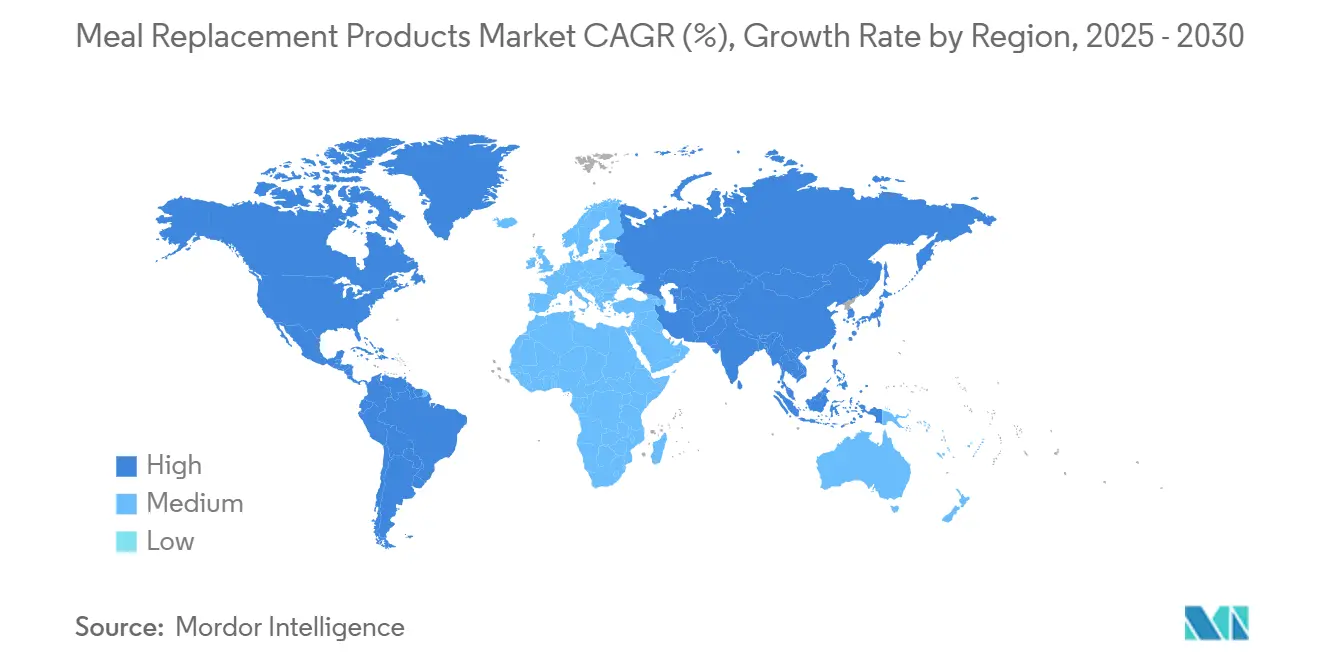
Competitive Landscape
The meal replacement market demonstrates moderate consolidation with a concentration rating of 6 out of 10, creating a competitive environment where established multinational corporations compete alongside innovative startups and regional specialists. Strategic acquisitions are reshaping market dynamics, exemplified by Simply Good Foods' USD 280 million acquisition of plant-based protein shake brand OWYN in June 2024, which is expected to generate approximately USD 120 million in sales and strengthen the acquirer's position in the fast-growing RTD segment. The competitive landscape is characterized by differentiation strategies that emphasize functional benefits, with companies leveraging scientific validation and regulatory approvals to justify premium positioning and build consumer trust.
The meal replacement products market features prominent players like Nestlé SA, Herbalife Nutrition, Abbott Laboratories, and Glanbia PLC, leading the competitive landscape. These meal replacement companies are heavily focused on product innovation as their primary growth strategy, with significant investments in research and development to launch new flavors, formats, and functional benefits that cater to evolving consumer preferences. Operational agility is demonstrated through rapid adaptation to market demands, particularly in expanding e-commerce capabilities and direct-to-consumer programs.
Technology integration is becoming a critical competitive differentiator, with companies investing in AI-driven personalized nutrition platforms and advanced food processing technologies to enhance product efficacy and consumer experience. The FDA's approval of novel proteins through GRAS notices, including beta-lactoglobulin produced by Aspergillus oryzae and fermented pea protein, is enabling ingredient innovation that supports competitive advantage.
Meal Replacement Products Industry Leaders
-
Abbott Laboratories
-
The Simply Good Foods Company (Atkins)
-
Glanbia PLC
-
Nestlé S.A.
-
Herbalife Nutrition Ltd.
- *Disclaimer: Major Players sorted in no particular order
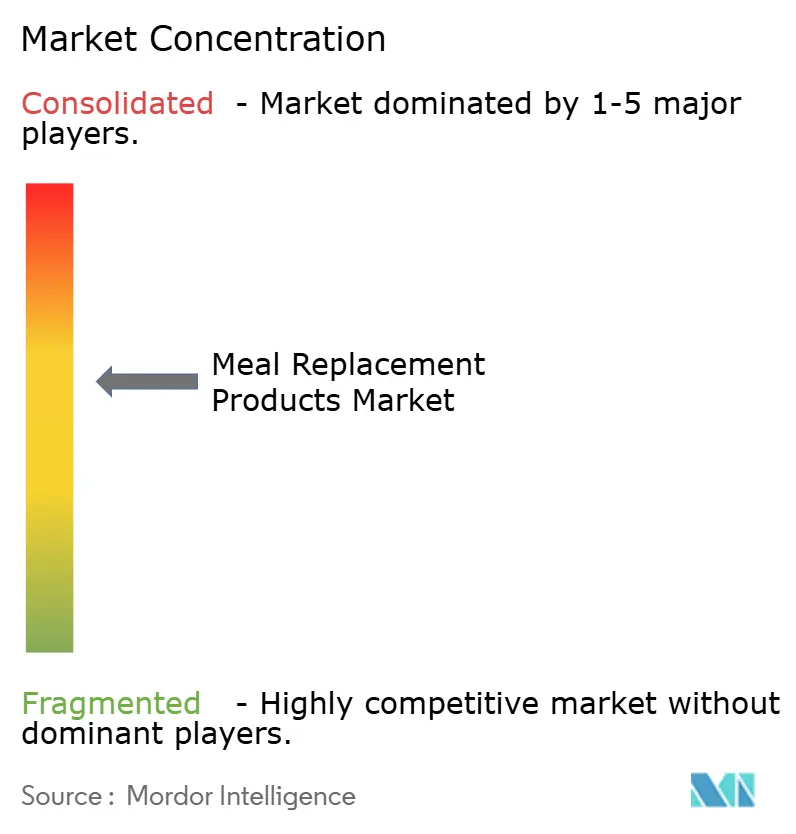
Recent Industry Developments
- June 2025: Danone North America launched Oikos Protein Shakes, expanding into the USD 7 billion ambient protein shakes market with shelf-stable products containing 30g protein and 5g prebiotic fiber, targeting mainstream consumers through major retailers including Kroger and Walmart
- June 2025: One and Hershey's introduced a double chocolate protein bar featuring Hershey's cocoa and chocolate chips. The protein bar contains 18g of protein and 1g of sugar per serving. The product targets consumers who prefer protein-enriched snacks with traditional chocolate flavors.
- February 2025: Quest Nutrition launched Quest Protein Milkshakes containing 45g protein in 14oz bottles, representing the highest protein content in the ready-to-drink category with a lean nutritional profile of only 230 calories.
- January 2025: Ferrero Group announced the acquisition of its Power Crunch protein snacks brand from Bio-Nutritional Research Group Inc., expanding its portfolio in the better-for-you snacks category as part of strategic health-focused brand development.
Global Meal Replacement Products Market Report Scope
Meal replacement products are pre-packaged, caloriecontrolled products in a bar or powder mix that can be made into a shake or beverage, having been validated as safe and effective tools for weight loss (and weight maintenance).
The meal replacement products market is segmented based on product type into ready-to-drink products, nutritional bars, powdered products, and other product types. Based on distribution channels, the market studied is segmented into convenience stores, hypermarkets/supermarkets, specialty stores, online retailer stores, and other distribution channels. Based on geography, the market is segmented into North America, Europe, Asia-Pacific, South America, and Middle-East and Africa. The various health benefits associated with the consumption of meal replacement products are driving the growth of the market studied.
For each segment, the market sizing and forecasts have been done on the basis of value (USD million).
| Powdered Products |
| Ready-to-Drink Products |
| Nutritional Bars |
| Soups |
| Other Product Types |
| Bottles/Jars |
| Pouches |
| Tetra Packs and Cartons |
| Others |
| Conventional |
| Organic |
| Supermarkets/Hypermarkets |
| Convenience Stores |
| Specialty Stores |
| Online Retailers |
| Other Distribution Channels |
| North America | United States |
| Canada | |
| Mexico | |
| Rest of North America | |
| Europe | Germany |
| United Kingdom | |
| Italy | |
| France | |
| Spain | |
| Netherlands | |
| Rest of Europe | |
| Asia-Pacific | China |
| India | |
| Japan | |
| Australia | |
| Indonesia | |
| South Korea | |
| Rest of Asia-Pacific | |
| South America | Brazil |
| Argentina | |
| Colombia | |
| Rest of South America | |
| Middle East and Africa | South Africa |
| Saudi Arabia | |
| United Arab Emirates | |
| Rest of Middle East and Africa |
| By Product Type | Powdered Products | |
| Ready-to-Drink Products | ||
| Nutritional Bars | ||
| Soups | ||
| Other Product Types | ||
| By Packaging Format | Bottles/Jars | |
| Pouches | ||
| Tetra Packs and Cartons | ||
| Others | ||
| By Nature | Conventional | |
| Organic | ||
| By Distribution Channel | Supermarkets/Hypermarkets | |
| Convenience Stores | ||
| Specialty Stores | ||
| Online Retailers | ||
| Other Distribution Channels | ||
| By Geography | North America | United States |
| Canada | ||
| Mexico | ||
| Rest of North America | ||
| Europe | Germany | |
| United Kingdom | ||
| Italy | ||
| France | ||
| Spain | ||
| Netherlands | ||
| Rest of Europe | ||
| Asia-Pacific | China | |
| India | ||
| Japan | ||
| Australia | ||
| Indonesia | ||
| South Korea | ||
| Rest of Asia-Pacific | ||
| South America | Brazil | |
| Argentina | ||
| Colombia | ||
| Rest of South America | ||
| Middle East and Africa | South Africa | |
| Saudi Arabia | ||
| United Arab Emirates | ||
| Rest of Middle East and Africa | ||
Key Questions Answered in the Report
What is the current size of the meal replacement market?
The market stands at USD 15.12 billion in 2025 and is projected to reach USD 22.48 billion by 2030.
Which product format is growing fastest?
Ready-to-drink shakes are expected to grow at an 11.01% CAGR between 2025 and 2030, outpacing powders.
Why is Asia-Pacific considered the most promising region?
Rapid ecommerce expansion, localized flavors, and large pre-diabetic populations drive a 10.22% forecast CAGR.
What packaging trend should brands watch?
Sustainable cartons made with bio-based caps are gaining traction, growing at 9.25% CAGR as retailers favor eco-friendly solutions.
Page last updated on:
